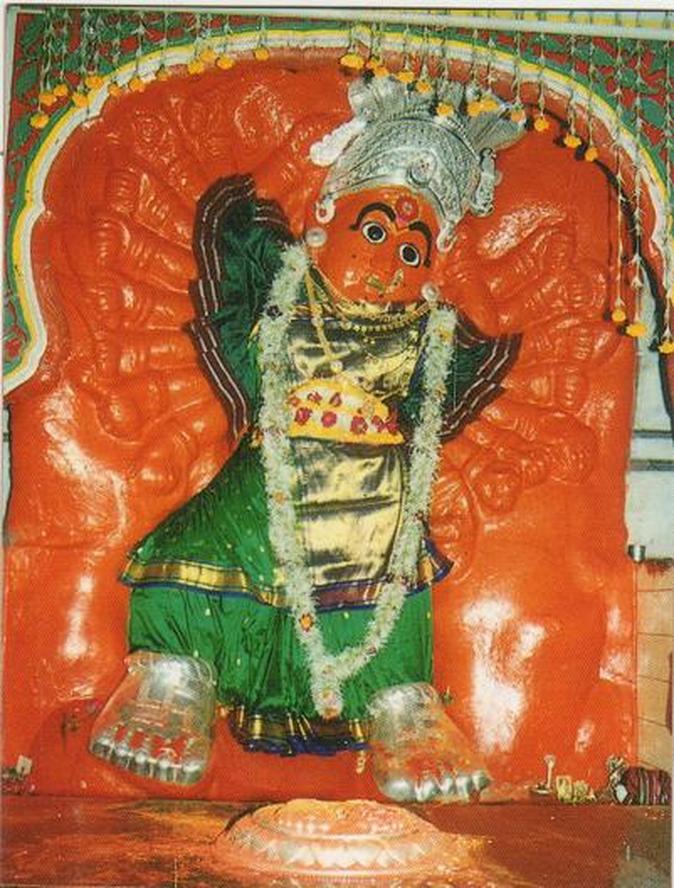
Shakti Peeth - Saptashrungi
Saptashrungi or Saptashringi is a site of pilgrimage situated 60 kilometers from Nashik. According to Hindu tradition, the goddess Saptashrungi Nivasini dwells within the seven mountain peaks. (Sapta means seven and shrung means peaks.) It is located in Nanduri, Tal:-Kalwan a small village near Nashik in India. Devotees visit this place in large numbers every day.
The legend
This temple is one among the 51 Shakti peethas located on the Indian subcontinent. The Devi is said be swayambhu (self-manifested) on a rock on the sheer face of a mountain. She is surrounded by seven (sapta in Sanskrit) peaks (shrungain Sanskrit), hence the name: Sapta Shrungi Mata (mother of the seven peaks).
The image of the Devi is huge — about 10 feet tall with 18 hands, holding weapons like:
String of Beads Battle Axe
Mace Arrow
Thunderbolt Lotus
Bow Water Pot
Cudgel Lance
Sword Shield
Conch Bell
Wine Cup Trident
Noose Spinning Disc (Sudarsana Chakra)
The idol is always coated with sindoor, which is considered auspicious in this region. She is also known as Mahishasur Mardini, the slayer of the demon Mahishasur, who took the form of a buffalo. At the foot of the hill, from where one starts climbing the steps, there is the head of a buffalo, made in stone which is believed to be a demon.
Mahishasur Mandir
It is believed that the Devi Mahatmya, a sacred book which extols the greatness of Devi and her exploits, was composed at this place by the sage Markandeya. He performed rigorous penance on a hill opposite the one where the Devi resides; it is now named after him. The temple, which is on the side of the cliff, is 1230 meters above sea level. There is an old path with steps cut out of the mountain, which starts right at the foothills at Vani and goes all the way to the mountain.
A motorable road has been built, which goes up to an altitude of 1150 meters. From this place one has to climb around 500 steps to reach the shrine, which takes about 45 minutes.
It is said that there is one flag which is said to be at top of the mountain where Saptashrungi mata's temple is situated. This road is only known by one person that is A poojari and no one else. Before his death he gives information of this hidden road to another poojari and this goes on. But only one poojari knows the way.
References in ancient texts and legends of Hinduism
Saptashrung mountain was a part of the forest called Dandakaranya mentioned in the Ramayana. It is mentioned that Lord Rama, along with Seeta, had come here to pray to Amba and seek her blessings.
Among the ancient seers, Sage Markandeya (who was called the Bhakta Markandeya and was the author of Devi Mahatmyam, the book containing 700 slokas praising and the life of the goddess Amba) and Sage Parashara ( son of Sakthi & grandson of Vasistha) completed their tapascharya (a multi-year period of meditation and prayer in solitude, a kind of penance, to seek the ultimate truth; in much of Hindu mythology, this is done to seek a meeting with God) at or near Saptashrungi.
Sant Dnyaneshwar, in Dnyaneshwari, his commentary on the Gita, mentions that his father, Vitthalpant, had also visited Saptashrungi. At a later point, Nivruttinath, the elder brother of Dnyaneshwara, is said to have visited Saptashrungi, and then moved on for his Samadhi at Tryambakeshwar near Nashik.[citation needed] (Samadhi means deep meditation. It can also mean a tomb of someone (usually a holy being) revered by masses. "Taking a Samadhi" means voluntarily entering one's own tomb with the purpose of giving up life, considering life's aim fulfilled.)
In Ashwin (Hindu calendar month) Shuddha Dhashami a big utsav (festival) is held at this place.
Saptashrungi or Saptashringi is a site of pilgrimage situated 60 kilometers from Nashik. According to Hindu tradition, the goddess Saptashrungi Nivasini dwells within the seven mountain peaks. (Sapta means seven and shrung means peaks.) It is located in Nanduri, Tal:-Kalwan a small village near Nashik in India. Devotees visit this place in large numbers every day.
The legend
This temple is one among the 51 Shakti peethas located on the Indian subcontinent. The Devi is said be swayambhu (self-manifested) on a rock on the sheer face of a mountain. She is surrounded by seven (sapta in Sanskrit) peaks (shrungain Sanskrit), hence the name: Sapta Shrungi Mata (mother of the seven peaks).
The image of the Devi is huge — about 10 feet tall with 18 hands, holding weapons like:
String of Beads Battle Axe
Mace Arrow
Thunderbolt Lotus
Bow Water Pot
Cudgel Lance
Sword Shield
Conch Bell
Wine Cup Trident
Noose Spinning Disc (Sudarsana Chakra)
The idol is always coated with sindoor, which is considered auspicious in this region. She is also known as Mahishasur Mardini, the slayer of the demon Mahishasur, who took the form of a buffalo. At the foot of the hill, from where one starts climbing the steps, there is the head of a buffalo, made in stone which is believed to be a demon.
Mahishasur Mandir
It is believed that the Devi Mahatmya, a sacred book which extols the greatness of Devi and her exploits, was composed at this place by the sage Markandeya. He performed rigorous penance on a hill opposite the one where the Devi resides; it is now named after him. The temple, which is on the side of the cliff, is 1230 meters above sea level. There is an old path with steps cut out of the mountain, which starts right at the foothills at Vani and goes all the way to the mountain.
A motorable road has been built, which goes up to an altitude of 1150 meters. From this place one has to climb around 500 steps to reach the shrine, which takes about 45 minutes.
It is said that there is one flag which is said to be at top of the mountain where Saptashrungi mata's temple is situated. This road is only known by one person that is A poojari and no one else. Before his death he gives information of this hidden road to another poojari and this goes on. But only one poojari knows the way.
References in ancient texts and legends of Hinduism
Saptashrung mountain was a part of the forest called Dandakaranya mentioned in the Ramayana. It is mentioned that Lord Rama, along with Seeta, had come here to pray to Amba and seek her blessings.
Among the ancient seers, Sage Markandeya (who was called the Bhakta Markandeya and was the author of Devi Mahatmyam, the book containing 700 slokas praising and the life of the goddess Amba) and Sage Parashara ( son of Sakthi & grandson of Vasistha) completed their tapascharya (a multi-year period of meditation and prayer in solitude, a kind of penance, to seek the ultimate truth; in much of Hindu mythology, this is done to seek a meeting with God) at or near Saptashrungi.
Sant Dnyaneshwar, in Dnyaneshwari, his commentary on the Gita, mentions that his father, Vitthalpant, had also visited Saptashrungi. At a later point, Nivruttinath, the elder brother of Dnyaneshwara, is said to have visited Saptashrungi, and then moved on for his Samadhi at Tryambakeshwar near Nashik.[citation needed] (Samadhi means deep meditation. It can also mean a tomb of someone (usually a holy being) revered by masses. "Taking a Samadhi" means voluntarily entering one's own tomb with the purpose of giving up life, considering life's aim fulfilled.)
In Ashwin (Hindu calendar month) Shuddha Dhashami a big utsav (festival) is held at this place.
 RSS Feed
RSS Feed

